Creating a welcoming space for birds during winter is not only rewarding but also essential for their survival. As natural food sources become scarce, birds rely heavily on feeders and other resources provided by humans. Over 60 million Americans engage in bird feeding, observing, and providing habitats for birds1.
Proper winterization helps birds endure harsh weather and builds a sustainable habitat. Planting native evergreens like spruce, cedar, fir, and hemlock can provide necessary winter shelter for various small mammals and songbirds2. Additionally, offering high-calorie foods such as suet, sunflower seeds, and peanuts can help birds conserve energy during the colder months3.
Common species like cardinals, finches, and sparrows are likely to visit your yard if you provide the right resources. Clean water is often the most challenging resource for birds to find, crucial for their hydration and health1. Installing a birdbath or pond can significantly aid in their survival, especially when equipped with a heating element to prevent freezing2.
Table of Contents
Key Takeaways
- Birds rely heavily on feeders during winter when natural food sources are limited.
- Planting native evergreens provides necessary shelter for birds.
- High-calorie foods like suet and sunflower seeds help birds conserve energy.
- Clean water is essential for bird survival, especially in winter.
- Installing a heated birdbath can prevent water from freezing.
Preparing Your Backyard for Winter Birding
Ensuring your yard is ready for winter birding involves more than just setting up feeders. A well-planned space provides shelter, food, and safety for birds during harsh weather. Start by evaluating your current setup and making necessary adjustments.
Assessing Your Current Setup and Natural Cover
Begin by examining your yard’s natural features. Dense shrubs, evergreens, and trees offer essential shelter for birds. These areas protect them from wind, snow, and predators4. If your yard lacks natural cover, consider planting native species like dogwoods or hollies, which also provide food sources5.
Next, check your existing feeders. Are they in good condition and properly stocked? Regularly cleaning feeders reduces the risk of disease transmission among birds4. Position them near thick vegetation to give birds quick access to cover if needed.

Implementing Safety Measures Around Windows and Feeders
Bird collisions with windows are a leading cause of fatalities, with about one billion birds dying annually from such impacts5. To prevent this, place feeders either within three feet of windows or more than 30 feet away. This reduces the chance of birds flying into glass at high speeds.
Consider using window decals or netting to make glass more visible. Additionally, ensure feeder areas are well-lit and protected from predators like squirrels. These steps create a safer environment for birds to feed and thrive.
| Checklist for Winter Birding Preparation |
|---|
| Evaluate natural cover (shrubs, trees, evergreens) |
| Clean and stock existing feeders |
| Position feeders near dense vegetation |
| Install window decals or netting |
| Protect feeder areas from predators |
By following these steps, you can create a welcoming and safe habitat for birds this winter. Your efforts will not only support their survival but also bring joy as you observe their visits to your yard.
Winterize Your Backyard: The Complete Guide to Attracting Birds in Cold Weather
Setting up the right feeders and food sources can make your space a haven for birds during the colder months. Choosing the correct feeder types and high-energy foods ensures birds stay healthy and active.
Selecting Ideal Feeders, Seeds, and Suet Options
Different species require specific feeders. Tube feeders are great for finches, while hopper feeders attract cardinals and sparrows6. Suet feeders, on the other hand, are perfect for woodpeckers and other high-energy birds7.
When it comes to food, opt for high-calorie options. Sunflower seeds, peanuts, and suet provide the energy birds need to survive freezing temperatures7. Thistle seeds are ideal for attracting finches and goldfinches6.
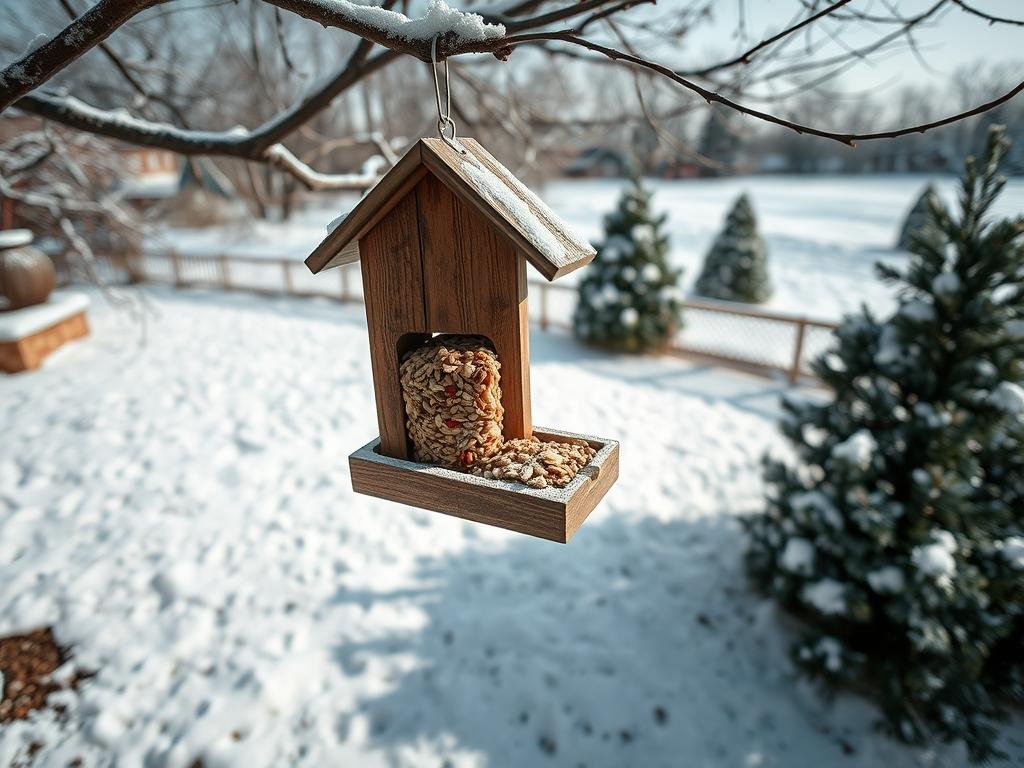
Strategically Placing Feeders and Water Sources
Place feeders near natural cover like shrubs or trees. This gives birds quick access to shelter from predators and harsh weather6. Avoid placing them too close to windows to reduce collision risks7.
Water is just as important as food. Install a heated bird bath to ensure birds have access to unfrozen water. Shallow basins freeze less quickly and are easier to maintain7.
- Use tube feeders for finches and hopper feeders for larger birds.
- Offer high-calorie foods like sunflower seeds and suet.
- Position feeders near natural cover for safety.
- Install heated bird baths to provide unfrozen water.
By selecting the right feeders and placing them strategically, you can create a welcoming habitat for birds all winter long. Regular maintenance, like cleaning and refilling, ensures they keep coming back.
Creating a Bird-Friendly Winter Habitat in Your Yard
Transforming your yard into a sanctuary for birds during winter requires thoughtful planning and natural elements. By incorporating native plants, evergreens, and brush piles, you can provide essential shelter and protection from harsh weather. These modifications not only support bird survival but also enhance the diversity of species visiting your space.
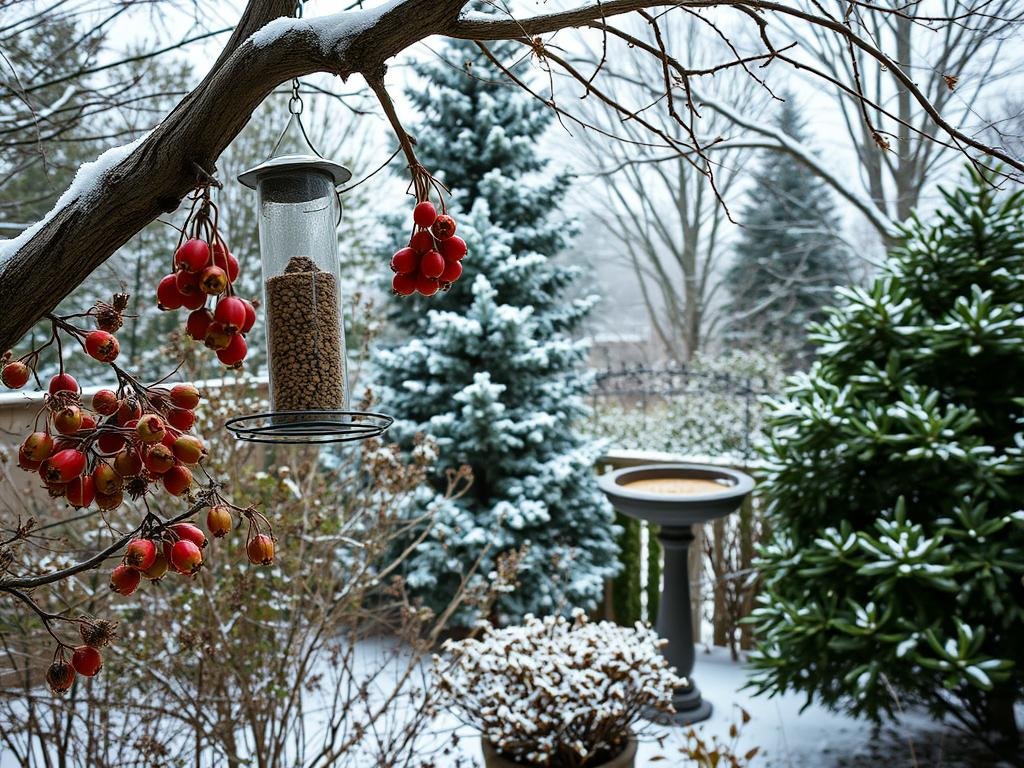
Utilizing Evergreens and Native Plants for Shelter
Evergreens like spruce, cedar, and fir offer year-round shelter for birds, shielding them from wind and snow8. Native plants such as dogwoods and hawthorns produce small fruits that serve as vital food sources during colder months9. Planting these species ensures birds have access to both food and protection.
Native grasses and wildflowers, like bluestems and coneflowers, also play a crucial role. Their seed heads provide foraging opportunities, while their dense foliage creates safe nesting areas9. These plants are low-maintenance and thrive in natural conditions, making them ideal for any yard.
Building Brush Piles and Natural Hideaways
Brush piles made from fallen branches and leaves offer excellent shelter for birds like American Tree Sparrows and Black-capped Chickadees9. These structures act as windbreaks and safe roosting sites, protecting birds from predators and harsh weather.
To create a brush pile, stack branches loosely to allow airflow and space for birds to move. Place it near feeders or water sources to create an integrated safe zone. This setup encourages birds to stay longer in your yard.
- Plant evergreens and native shrubs for year-round shelter and food.
- Use fallen branches and leaves to build brush piles for protection.
- Position habitat elements near feeders and water sources for convenience.
- Preserve natural garden elements like leaf litter to support biodiversity.
By incorporating these elements, you can create a welcoming habitat that supports birds throughout the winter. Your efforts will not only aid their survival but also bring life and beauty to your yard.
Essential Bird Feeding Strategies for Cold Weather
Providing the right resources for birds during the colder months ensures their survival and brings life to your yard. Choosing the correct feeder types and maintaining them properly can make a significant difference in attracting diverse species.
Choosing the Right Feeder Types for Different Species
Different birds prefer specific feeders. Tube feeders are ideal for finches, while hopper feeders attract cardinals and sparrows10. Suet feeders, designed for high-energy species like woodpeckers, provide essential calories during winter11.
Upside-down feeders cater to nuthatches, allowing them to feed while hanging upside down10. Tail prop feeders are perfect for woodpeckers, offering better leverage while feeding10. Shelter feeders protect suet from harsh weather, keeping it fresh and accessible10.
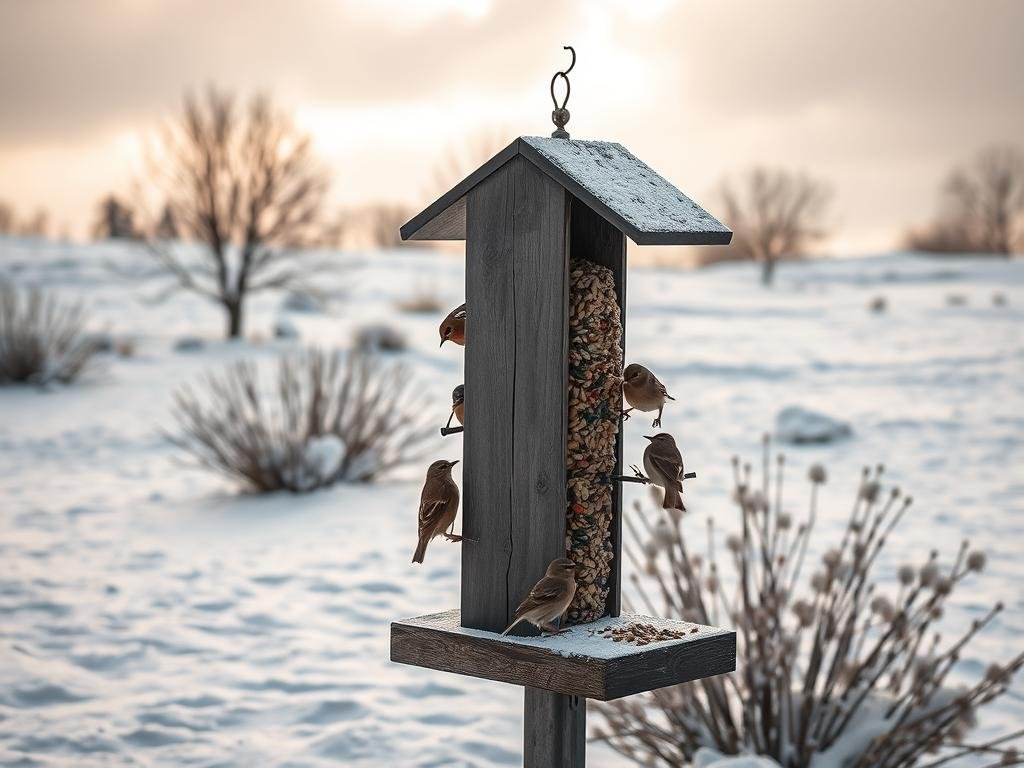
Maintenance Tips: Cleaning, Refilling, and Squirrel Proofing
Regular cleaning of feeders prevents mold and disease, ensuring a safe feeding environment12. Refill feeders every 2-3 weeks to keep food fresh and appealing12.
To deter squirrels, use baffles or mount feeders on poles12. Weight-sensitive models are particularly effective in preventing squirrels from accessing seed12. Positioning feeders near natural cover like shrubs or trees provides safety and convenience for birds10.
| Feeder Types and Their Ideal Species |
|---|
| Tube Feeders: Finches, Goldfinches |
| Hopper Feeders: Cardinals, Sparrows |
| Suet Feeders: Woodpeckers, Chickadees |
| Upside-Down Feeders: Nuthatches |
| Tail Prop Feeders: Woodpeckers |
By selecting the right feeder types and maintaining them properly, you can create a welcoming habitat for birds all winter long. Your efforts will not only support their survival but also bring joy as you observe their visits to your yard.
Conclusion
Supporting birds during the colder months can transform your space into a lively haven. By offering a variety of feeders and high-energy foods like suet and sunflower seeds, you can attract diverse species such as finches, sparrows, and woodpeckers13. Clean, fresh water is equally important, and a heated bird bath ensures it remains accessible even in freezing temperatures14.
Proper placement of feeders near natural cover like shrubs or trees provides safety and convenience for birds15. Regular maintenance, such as cleaning feeders and refilling them, keeps the food fresh and prevents disease15. These small steps create a welcoming habitat that supports avian survival and brings joy to your garden.
Start small and gradually expand your setup as you observe the results. Watching a vibrant winter bird population thrive in your space is a rewarding experience. Take action today and enjoy the beauty of nature right outside your house.
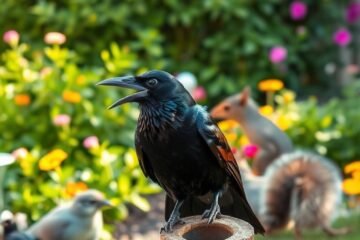
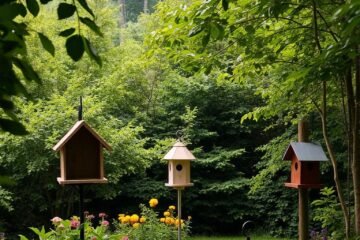
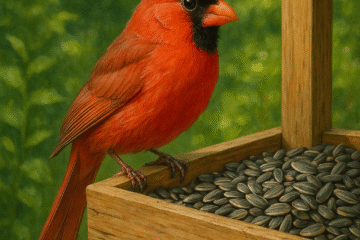
0 Comments